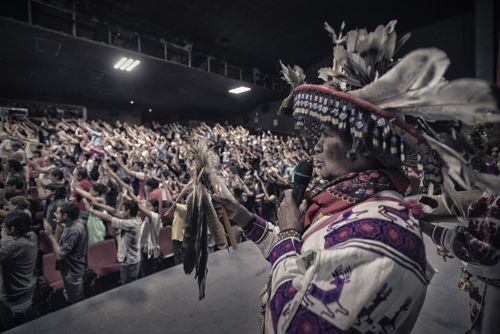Setting: Noon. Saturday, July 5, 2014. The Domino Sugar Factory, Williamsburg, NY
Outside the venue, a very long line winds down and around several blocks. Art aficionados wait patiently in the sun. Inside, the exhibition visitors wander and wonder. THE MARVELOUS SUGAR BABY regally inhabits the space. Docents are scattered throughout the venue.
VISITOR ONE: I think this exhibit is great for Black people.
VISITOR TWO: For Black people? Really? Why?
VISITOR ONE: Because this massive sculpture obviously celebrates Black matriarchy.
VISITOR TWO: Black matriarchy? Is that what you get from this? As in some romanticized free choice world that never existed, as opposed to coping because you have no choice?
VISITOR ONE: What do you mean?
VISITOR TWO: What did you mean?
VISITOR ONE: You don't have to get angry.
VISITOR TWO: You don't have to tell me how I feel. I can't talk to you about this.
VISITOR TWO quickly walks away from VISITOR ONE.
________________________________________________________________________________________________
VISITOR THREE, VISITOR FOUR, and VISITOR FIVE mingle on one the side of THE MARVELOUS SUGAR BABY.
VISITOR THREE: This is a great effort.
VISITOR FOUR: That's an understatement. It's wonderful.
VISITOR FIVE: Did you check out the Mammy scarf?
VISITOR FOUR: I know. We'll never get away from that.
VISITOR FIVE: Yeah, you know they took Aunt Jemima off the pancake box and gave her a perm--
VISITOR FOUR: Or a press n' curl. And earrings.
Laughing, VISITOR THREE, VISITOR FOUR, and VISITOR FIVE move around to another view, in back of THE MARVELOUS SUGAR BABY. VISITOR THREE grimaces.
VISITOR THREE: I mean, Kara Walker is very good, but....
VISITOR FOUR: But what about Kara Walker?
VISITOR THREE: She's no Jeff Koons.
VISITOR FIVE: Thank God for that.
________________________________________________________________________________________________
VISITOR SIX and VISITOR SEVEN linger in front of a melting molasses statue of a young Black child. VISITOR SIX sighs into VISITOR SEVEN's chest.
VISITOR SIX: Do you think this statue is supposed to be an enslaved child?
VISITOR SEVEN: I don't know, but that'd make sense.
VISITOR SIX: It's melting right in front of us.
VISITOR SEVEN: And what do you get from that?
VISITOR SIX: Dying Black children, separated from their mother because of slavery? Some melting, some not. Look how far they're scattered about. None of the statues of children are really next to the mother, the sphinx. You know what I mean.
VISITOR SEVEN: I do. Kara Walker went from those intricate paper cutouts to this huge, towering expression of--
VISITOR SIX: Of all these isms we don't like to think about. I know. I know. So many layers. This is overwhelming.
VISITOR SEVEN: Yeah, it is.
VISITOR SIX: Which form do you like better?
VISITOR SEVEN: I can't say. Both are...monumental.
VISITOR SIX: Her cutouts are so delicate and powerful. You're taken in before you realize what's happening in them. Kara Walker is---
VISITOR SEVEN: Effin' brilliant?
VISITOR SIX: That works.
VISITOR SIX takes VISITOR SEVEN's hand, and they move several yards over to study THE MARVELOUS SUGAR BABY.
___________________________________________________________________________________________
VISITOR EIGHT and VISITOR NINE stand near a docent, listening to her talk about Kara Walker's work.
VISITOR EIGHT: Let's go.
VISITOR NINE: Honey we're almost through. Listen to the docent.
VISITOR EIGHT: I'm hungry.
VISITOR NINE: We'll eat later. Shhhh.
Holding out his hand, VISITOR EIGHT breaks from the small group listening to the docent, and runs over to THE MARVELOUS SUGAR BABY. The docent stops speaking and looks at VISITOR NINE, sharply.
VISITOR EIGHT: Can we eat this?
VISITOR NINE moves quickly to block VISITOR EIGHT's hand from digging into THE MARVELOUS SUGAR BABY.
VISITOR NINE: What are you doing?
VISITOR EIGHT: I'm hungry.
VISITOR NINE retrieves a snack bag from her pocketbook, and roughly places trail mix in VISITOR EIGHT's hand.
VISITOR TEN and VISITOR ELEVEN stand in front of THE MARVELOUS SUGAR BABY, camera phones at the ready.
VISITOR TEN: Go on. I'll take yours first.
VISITOR ELEVEN walks directly in front of THE MARVELOUS SUGAR BABY.
VISITOR TEN (CONT'D): Move over. You're right in-between the breasts.
VISITOR ELEVEN: I don't have a problem with that.
VISITOR TWELVE and VISITOR THIRTEEN begin to exit the venue.
VISITOR TWELVE: I wonder what it would have looked like made from brown sugar.
VISITOR THIRTEEN: And what color brown? Light or dark? It would be a completely different exhibit.
VISITOR TWELVE: Definitely. Isn't brown sugar healthier?
VISITOR THIRTEEN: I know brown sugar isn't bleached. It's pure, unrefined.
VISITOR TWELVE: Really? You think she meant that? I mean Kara Walker used white sugar for The Marvelous Sugar Baby instead of brown because of that?
VISITOR THIRTEEN: You have a future as an art critic.
VISITOR TWELVE: Shut up.
They continue to exit. VISITOR TWELVE glances back at a sidewall.
VISITOR TWELVE (CONT'D): I really liked that hole in the wall looking out on the river. She puts The Middle Passage in your face.
VISITOR THIRTEEN: Not to mention body parts.
VISITOR TWELVE and VISITOR THIRTEEN near the exit ramp.
VISITOR THIRTEEN (CONT'D): We cut it close. I'm glad we got in.
VISITOR TWELVE: Me too. My mind is racing. Oh my God, I feel high--on this exhibition.
VISITOR THIRTEEN: That's what great art can do, right?
They begin to walk up the exit ramp.
VISITOR TWELVE: What is this brown sticky stuff under our feet? This ramp is dirty. Someone should clean it up.
VISITOR THIRTEEN: Yes. Someone should.
As the visitors, the media, and the art world move through, into and out of the space, THE MARVELOUS SUGAR BABY looks on: smiling, melting, crying, laughing, and frowning. She waits.










































